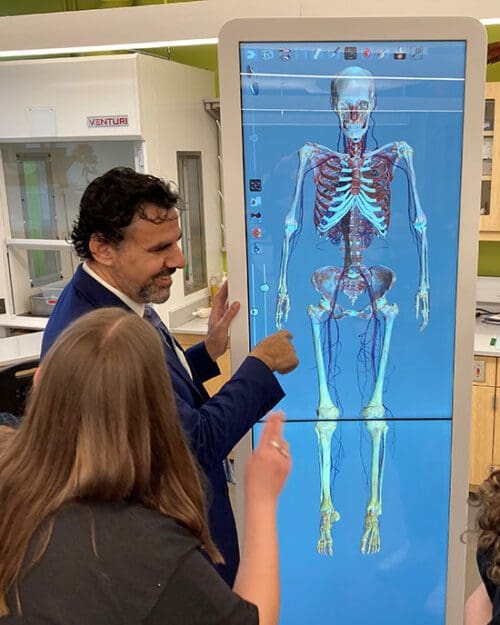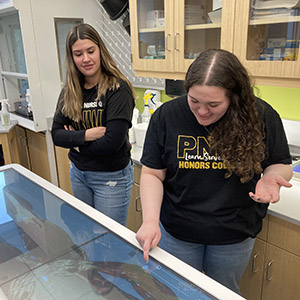Virtual Anatomy Tables Fuel High-Tech Learning

Hassan Naji, left background, lecturer of Biological Sciences and Integrative Human Health, reviews anatomy & physiology concepts with Nursing students in a Nils K. Nelson Bioscience Innovation Building lab space.
Students in anatomy, physiology, and nursing courses at Purdue University Northwest (PNW) are training with a more in-depth and interactive view of the human body thanks to two high-tech Anatomage tables being steered by faculty members in the department of Biological Sciences and the College of Nursing.
The tables function as interactive 3D visualizations of the human anatomy that demonstrate the interconnectedness of various bodily functions, but can also essentially serve as a virtual cadaver to benefit pathophysiology lessons. The tables are used in the state-of-the-art Nils K. Nelson Bioscience Innovation Building and the Technology Building.
The tables come preprogrammed with several cadavers whose families donated their stories to be used with the tables. The tables allow users to go layer by layer with the body to essentially virtually dissect it and determine the factors that contributed to a person’s ailments.
Julia Rogers, assistant professor of Nursing, says the technology is a major positive for beginning and advanced Nursing students. Rogers says undergraduate students are focused on assessment with the signs and symptoms of ailments while graduate students go the next step of diagnosing and recommending treatments.
“For my master’s program, we did not have cadavers, so we did a lot of things in the lab. We went to clinicals and saw real patients, but the problem is, in your head, you are just looking at 2D images in your book that say ‘this is what the inside of the body looks like when this disease is happening, now you have to figure out how all of that connects.’”
“But the tables actually give the students that viewpoint from the inside. So I think they are going to be much better at not only assessing but being able to put a path in place — this is the patient’s complaint, so here are the body sections I need to be looking at.”
Knowing the anatomy of the body helps us trace disease through the body and better understand the system...I think it’s an important piece of technology in the classroom.
Hassan Naji, lecturer of Biological Sciences and Integrative Human Health, makes frequent use of the tables in his anatomy and physiology and biomechanics class sections. He even has two different students who will use the tables for a project on the autonomic nervous system and the other for an internship.
Naji says he has taken students outside of the classroom to observe actual cadavers. While the experience is certainly valuable, the Anatomage tables allow for quicker demonstration and require no cleanup.
“I can do different views and save them for later use, I can do quizzes, make an animation or small video, and I can reuse those visuals again — with one click I can bring everything back,” said Naji. “It holistically provides a good image of the body. It comes with every possible thing you need with anatomy.”

Second-year Nursing students Angelica Castillo, left, and Loretta Santino work with the Anatomage table’s functions in a Nils K. Nelson Bioscience Innovation Building lab space.
Nursing students Loretta Santino and Krista Dietz feel the Anatomage tables provide significantly valuable insights to benefit their knowledge of the human body for their future studies in the program.
“Knowing the anatomy of the body helps us trace disease through the body and better understand the system,” said Santino. “It’s something you wouldn’t expect to use when you get into the program. Before it was just a picture, but a picture doesn’t show you things like how blood is moving. You would otherwise have to infer those things. I think it’s an important piece of technology in the classroom.”
“It can really help with physical exams and finding pulses,” said Dietz. “Knowing the area of the bodies to do injections is a basic for anyone who goes into a medical profession. In our smaller group settings in the classroom I’ve gained a lot from working with it.”
To learn more about studying Biological Sciences or Nursing at PNW, visit pnw.edu/biological-sciences or pnw.edu/nursing.